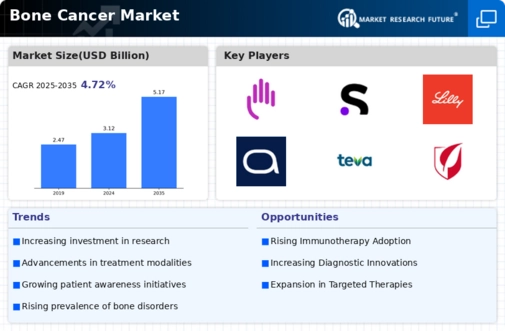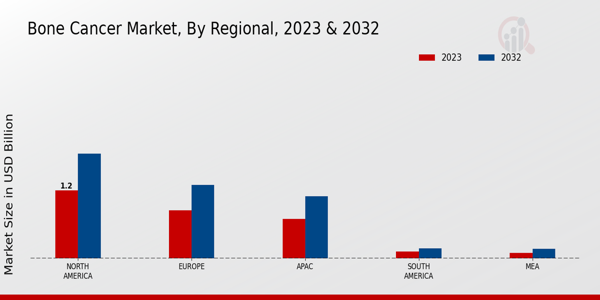Market Trends and Projections
The Global Bone Cancer Market Industry is characterized by several key trends and projections that shape its future. As of 2024, the market is valued at 3.12 USD Billion, with expectations to reach 5.17 USD Billion by 2035. The compound annual growth rate is projected at 4.69% from 2025 to 2035. These figures highlight the increasing focus on bone cancer treatment and the need for innovative solutions. Factors such as rising incidence rates, advancements in therapies, and growing awareness are driving this growth, indicating a robust future for the industry.
Rising Incidence of Bone Cancer
The Global Bone Cancer Market Industry is experiencing growth due to the increasing incidence of bone cancer worldwide. According to recent statistics, the prevalence of primary bone cancers, such as osteosarcoma and Ewing sarcoma, is on the rise, particularly among adolescents and young adults. This trend is likely to drive demand for innovative treatment options and diagnostic tools. As the global population ages, the incidence of secondary bone cancers, often stemming from other malignancies, is also expected to increase. This growing patient population necessitates advancements in therapies and healthcare services, contributing to the projected market value of 3.12 USD Billion in 2024.
Advancements in Treatment Modalities
Innovations in treatment modalities are significantly influencing the Global Bone Cancer Market Industry. The introduction of targeted therapies and immunotherapies has transformed the landscape of bone cancer treatment, offering patients more effective options with fewer side effects. For instance, the use of monoclonal antibodies and checkpoint inhibitors has shown promising results in clinical trials. Additionally, advancements in surgical techniques, such as limb-salvage procedures, have improved patient outcomes. These developments not only enhance survival rates but also contribute to the market's growth, with projections indicating a market value of 5.17 USD Billion by 2035.
Growing Awareness and Screening Programs
There is a notable increase in awareness regarding bone cancer, which is positively impacting the Global Bone Cancer Market Industry. Public health campaigns and educational initiatives are encouraging early detection and timely intervention. Screening programs aimed at high-risk populations are being implemented in various regions, facilitating earlier diagnosis and treatment. This proactive approach is expected to improve patient outcomes and reduce mortality rates associated with bone cancer. As awareness continues to grow, the demand for diagnostic services and treatment options is likely to rise, further propelling the market's expansion.
Increased Research and Development Investments
The Global Bone Cancer Market Industry is benefiting from heightened investments in research and development. Governments and private organizations are allocating substantial funds to explore novel therapeutic approaches and improve existing treatments. For example, initiatives aimed at understanding the genetic and molecular underpinnings of bone cancer are paving the way for personalized medicine. This focus on R&D is expected to yield breakthroughs that could enhance treatment efficacy and patient quality of life. As a result, the market is anticipated to grow at a compound annual growth rate of 4.69% from 2025 to 2035, reflecting the commitment to advancing bone cancer care.
Emerging Markets and Healthcare Infrastructure Development
The Global Bone Cancer Market Industry is witnessing growth in emerging markets, where healthcare infrastructure is rapidly developing. Countries in Asia-Pacific and Latin America are investing in healthcare facilities and services, enhancing access to cancer care. This expansion is accompanied by an increase in the availability of advanced diagnostic tools and treatment options. As these regions continue to improve their healthcare systems, the demand for bone cancer treatments is expected to rise. This trend not only reflects a growing patient population but also indicates a shift towards more comprehensive cancer care, contributing to the overall market growth.
























Leave a Comment